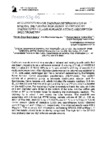Use este identificador para citar ou linkar para este item:
http://www.alice.cnptia.embrapa.br/alice/handle/doc/866622Registro completo de metadados
| Campo DC | Valor | Idioma |
|---|---|---|
| dc.contributor.author | GUERRA, M. B. B. | pt_BR |
| dc.contributor.author | NOGUEIRA, A. R. de A. | pt_BR |
| dc.contributor.author | SILVA, P. H. T. | pt_BR |
| dc.contributor.author | PEREIRA FILHO, E. R. | pt_BR |
| dc.date.accessioned | 2011-07-20T01:09:55Z | - |
| dc.date.available | 2011-07-20T01:09:55Z | - |
| dc.date.created | 2010-11-10 | pt_BR |
| dc.date.issued | 2010 | pt_BR |
| dc.identifier.citation | In: RIO SYMPOSIUM ON ATOMIC SPECTROMETRY, 11., 2010, Mar del Prata: Horiba, 2010. | pt_BR |
| dc.identifier.uri | http://www.alice.cnptia.embrapa.br/alice/handle/doc/866622 | pt_BR |
| dc.description | Cadmium was determined in a sample of mineral salt mixing to milk cattle that has been preparing to be a reference material. A volume of 3 mL of HNO3 3.0 mol L-1 plus 2.0 of H202 30% (W w-1) was added to 250 mg of sample in a cavity microwave oven. After digestion performance the volume was adjusted to 10 mL with water, centrifuged and the supernatant determined by thermospray flame furnace atomic absorption spectrometry (TS-FF-AAS). The system consist of a peristaltic pump, a lab-made commutator injector, and the thermospray flame furnace unit, which includes the ceramic capillary (0.5 mm 10,2.0 mm ED and 100 mm of length) and the Ni tube (10 cm) which is located on the AAS burner. For reaching a higher temperature inside the tube, six holes of 2 mm diameter were drilled in the bottom of the tube. Another orifice was drilled at 90' to the bottom holes for inserting the thermospray capillary. The capillary tip is about 1 mm inside the tube furnace. The manifold was assembled with 0.5 mm i.d. PTFE tubing, sample volume of 1 00 uL, 0.5 mL min-1 of flow rate, and 0.5 % (w v-1) EDTA plus 0.1 % (v v-1) Triton X 100 as carrier stream. Limits of detection (LOD) and quantification (LOQ) 'obtained were 0.31~g L-1 and 1.02~gL-1, respectively. The obtained results were 402 +- 35ug L-1. The accuracy was checked by performing GFAAS (465 +-95ug L-1) and the results proved to be similar by using t test. The high rsd in the GFAAS was probably due the high chloride sample amount. | pt_BR |
| dc.language.iso | por | pt_BR |
| dc.rights | openAccess | pt_BR |
| dc.subject | Acid digestion | pt_BR |
| dc.subject | Atomic absorption | pt_BR |
| dc.subject | Spectrometry | pt_BR |
| dc.title | Acid digestion for cadmium determination in mineral salt mixing for animal nutrition by thermospray flame furnace Atomic absorption spectrometry. | pt_BR |
| dc.type | Resumo em anais e proceedings | pt_BR |
| dc.date.updated | 2011-07-20T01:09:55Z | pt_BR |
| dc.subject.nalthesaurus | animal nutrition | pt_BR |
| dc.format.extent2 | p. 336 | pt_BR |
| riaa.ainfo.id | 866622 | pt_BR |
| riaa.ainfo.lastupdate | 2011-07-19 | pt_BR |
| dc.contributor.institution | MARCELO BRAGA BUENO GUERRA, UFSCar/SÃO CARLOS, SP.; ANA RITA DE ARAUJO NOGUEIRA, CPPSE; PATRICIA HELENA TONIOLO SILVA, UFSCar/SÃO CARLOS, SP.; EDENIR RODRIGUES PEREIRA FILHO, UFSCar/SÃO CARLOS, SP. | pt_BR |
| Aparece nas coleções: | Resumo em anais de congresso (CPPSE)  | |
Arquivos associados a este item:
| Arquivo | Descrição | Tamanho | Formato | |
|---|---|---|---|---|
| PROCI2010.00194.pdf | 114,83 kB | Adobe PDF |  Visualizar/Abrir |









